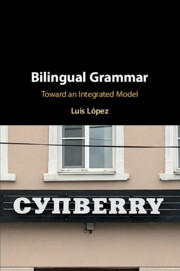Book contents
- Bilingual Grammar
- Bilingual Grammar
- Copyright page
- Contents
- Figures
- Acknowledgments
- 1 Introduction: Motivating a Unified Linguistic System
- 2 Remarks on Separationist Architectures
- 3 Phases, Distributed Morphology, and Some Contributions from Code-Switching
- 4 1Lex in MDM
- 5 Building the Case for 1Lex: Gender in Code-Switching
- 6 1PF in MDM
- 7 Lexical Questions: What Do You Learn When You Learn a Word?
- 8 Psycho-Syntactic Questions: Acquisition, Priming and Co-activation, and a Note on Processing Cost
- 9 Convergent and Divergent Paths
- 10 General Conclusions
- Book part
- Notes
- References
- Index
2 - Remarks on Separationist Architectures
Published online by Cambridge University Press: 02 May 2020
- Bilingual Grammar
- Bilingual Grammar
- Copyright page
- Contents
- Figures
- Acknowledgments
- 1 Introduction: Motivating a Unified Linguistic System
- 2 Remarks on Separationist Architectures
- 3 Phases, Distributed Morphology, and Some Contributions from Code-Switching
- 4 1Lex in MDM
- 5 Building the Case for 1Lex: Gender in Code-Switching
- 6 1PF in MDM
- 7 Lexical Questions: What Do You Learn When You Learn a Word?
- 8 Psycho-Syntactic Questions: Acquisition, Priming and Co-activation, and a Note on Processing Cost
- 9 Convergent and Divergent Paths
- 10 General Conclusions
- Book part
- Notes
- References
- Index
Summary
Ths chapter introduces MacSwann’s (1999) model. It is a minimalist framework within separationist assumptions to the extent that it is claimed that the bilingual has two lexicons and two PFs. The chapter also presents two empirical challenges to this model: mixed selection and noun classes. Mixed selection refers to the empirical fact that an item from “one lexicon” may select for an item in “the other” lexicon. Under the label “noun classes,” I show that an English noun can be inserted into a Swahili discourse, in the process acquiring a noun class. Both these well-known features of code-switching are empirical problems for any theory that posits separate lexicons. The chapter ends with a brief discussion of Multiple Grammar Theory highlighting the points of contact and divergence with the integrationist approach.
- Type
- Chapter
- Information
- Bilingual GrammarToward an Integrated Model, pp. 12 - 21Publisher: Cambridge University PressPrint publication year: 2020

